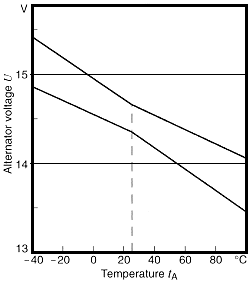 |
 |
 |
 |

|


|
|
|
|
|
|
|||||||
 |
|
|
LinkBack | Thread Tools | Display Modes |
|
|
|
#1
|
|||
|
|||
|
In general if a car is driving does it still charge the battery when full
In general does a car keep charging the battery even if the battery is full when driving. Or is there a device that cut current to charging the battery.
__________________
Silver Honda Accord, 2006 Silver G500, 2003 Silver SLK-320, 2002 Black ML-320, 2000 Bule Porsche 993 Targa , 1997 Silver Merkur XR4Ti, 1987 |
|
#2
|
|||
|
|||
|
No, the alternator stops when the system voltage reaches the voltage regulators highest allowable amount usually around 14.2 VDC. If the alternator kept putting out current to the battery, it would boil the liquid out of the battery and ruin the battery in short order.
__________________
"Rudeness is a weak man's imitation of strength" - Eric Hoffer |
|
#3
|
|||
|
|||
|
What kind of car and are you having a problem?. Some Honda cars delay the start of the alternator charging and some newer cars vary the voltage for some reason.
To expand on more " normal "cars , the alternator regulator is a constant voltage regulator set at a voltage that the battery won't become overcharged. This is in the 13.8 ish volt for pre 76 ish regardless of brand and 14.5 ish range for 76 + cars that used maintenance free batteries. Maintenance free batteries need more voltage to push in a charge. We control the voltage ( pressure of electricity ) so we don't damage the battery / boil off the water. The amperage ( volume of electricity ) isn't controlled on a typical alternator system. Older generator based charging systems worked the same but added current limiting so the generator would not be damaged. Regardless of if generator or alternator, voltage will drop off if too many loads are applied to the system when the engine is idling as the system just can't make enough electricity. |
|
#4
|
|||
|
|||
|
97, Maybe we are saying the same thing in a different way...my understanding is that the voltage regulator controls the energy sent to energize the field which changes the strength of the magnets which in turn modulates the current output of the alternator. An alternator doesn't put out full current all the time, the regulator senses the need via voltage and tapers/supplies and appropriate signal to the field controlling the current output.
__________________
"Rudeness is a weak man's imitation of strength" - Eric Hoffer |
|
#5
|
|||
|
|||
|
Yes, the regulator controls system voltage by energizing/de-energizing the field coil, which is in the rotor, at fairly high frequency. If you look at alternator voltage with a low response time scope, it looks like a square wave. Regulators typically maintain 13.5 - 14.5 average volts, depending on temperature. A "hot" alternator will maintain higher voltage than when it's cold.
As electrical load (current demand) increases, voltage from a constant voltage source like a battery drops off, but the regulator keeps the field coils energized at a higher duty cycle as load increases in order to maintain system voltage in the above range. If load is so high that system voltage drops below about 13.5 the field coil is continuously energized. This can happen at idle speed with a maximum load, but most alternators are sized to provide near maximum load at idle speed. Alternator amp ratings are usually specified with the alternator spinning at 3000-5000 RPM and maximum acceptable rotor speed is about 18,000. A fully charged lead acid battery should measure about 12.6 volts at room temperature, so if the alternator has enough current capacity to carry the load and maintain system voltage, there will always be a slight back current on the battery. Battery chargers work the same way... provide a back voltage higher than 12.6 to charge the battery. A typical 2/10 amp charger has two settings. At the 10 amp setting back voltage is higher than at the 2 amp setting. My charger shows about 2 amps on the meter when the battery is fully charged. At the 2 amp setting it shows essentially zero. Duke |
|
#6
|
|||
|
|||
|
Quote:
Just the opposite: the alternator's output decreases with temperature. 
|
|
#7
|
|||
|
|||
|
This is by design as a hot battery can't tolerate high voltages. Some cars look at ambient temperature to adjust voltage. This occurred on 80's Chrysler products. |
 |
| Bookmarks |
|
|